 Mike Driehorst had a birthday on September 18. And I was so busy, I hadn’t read my feedreader in several days.
Mike Driehorst had a birthday on September 18. And I was so busy, I hadn’t read my feedreader in several days.
Here’s a belated birthday toast to you, Mike!

 Mike Driehorst had a birthday on September 18. And I was so busy, I hadn’t read my feedreader in several days.
Mike Driehorst had a birthday on September 18. And I was so busy, I hadn’t read my feedreader in several days.
Here’s a belated birthday toast to you, Mike!
 Julie Ruscolelli, the founder of Maverick PR has started a blog.
Julie Ruscolelli, the founder of Maverick PR has started a blog.
Julie is, to my knowledge, the only other CEO of a Canadian PR firm who is blogging. She joins the ranks of Steve Cody and Richard Edelman. Have I missed any other PR firm CEO’s who are blogging?
So, to keep me from being lonely, please subscribe to Julie’s blog.
Now, if I could only figure out how to pronounce her name….
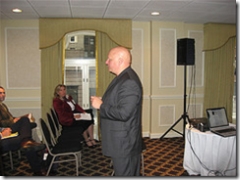 Executive Blogging: Is it worth it?
Executive Blogging: Is it worth it?
Many executives ask, “Should I blog?” In Steve Crescenzo’s experience, the right question for many of them is “Can I blog?” In fact, says Steve, many executives lack the writing skills necessary to blog.
For those who can write, the blog can be an incredibly effective tool.
In assessing whether an executive should blog, you must match the tool to the executive’s skills. If they don’t match, stay away.
Why do blogs work?
Having said this, many senior executives are not inclined to learn even the basic software. They are also rarely conversational in their communication. Many executives have been trained to see written communications as formal and stiff. They may be great communicators in a one to one conversation. But they stiffen up and become formal and “official” in their writing. Steve calls this the “Homicide Detective Syndrome” – the tendency to clam up and speak in “officialese” the second the cameras turn on. This doesn’t match the conversational nature of blog writing.
Executives are also prone to spin. They are reluctant to acknowledge bad news. When was the last time you read an executive statement that said, “We have a problem.” No, you’ll read, “We have a challenge.” In corporate spin, “challenge” is used as a euphemism for “problem.”
Written executive statements also relentlessly use clichés. “The only constant is change.” “Employees are our greatest asset.” “We’re uniquely positioned in our global marketplace.”
None of this works on blogs.
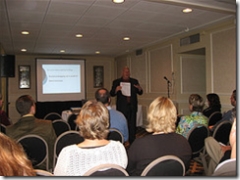 So, why do executives want to blog?
So, why do executives want to blog?
Why SHOULD execs want to blog?
Five mistakes to avoid:
When do you know an executive blog is working? When your executive blogger is able to say that the feedback on the blog has influenced his decision-making. And when your community becomes actively engaged with you.
Bob Lutz’s GM Fastlane blog has both of these qualities. Why does it work?
So, how to get started? An executive who wants to blog could start with an internal blog. This will allow her to find her voice and become comfortable with blogging before launching an external blog.
Internal blogs do not need to be open ended. Temporary blogs can be established around specific events, such as an industry conference, marketing expos, stakeholder consultations, etc. Such a “hit and run” blog enables the executive to blog for a finite period of time about a subject that she has something to talk about. When the event is over, the blog posts end.
 OK. The last gasp. The home stretch. Man, are my fingers tired!
OK. The last gasp. The home stretch. Man, are my fingers tired!
Today, I hope to take in and report on:
Journalists who blog: Are there new pitching ground rules?: The program did not tell me who will be on the panel. But with a title like this, how could I resist?
So your boss wants to be a blogger? Better talk to Steve first with Steve Crescenzo.
And finally:
What’s killing PR and how can we fix it? Boy, the answer to this alone will be worth the price of admission!
 Next Tuesday, Shel Israel will kick off the OCRI Zone5ive season of meetups of Ottawa technology marketers.
Next Tuesday, Shel Israel will kick off the OCRI Zone5ive season of meetups of Ottawa technology marketers.
 Shel is co-author with Robert Scoble of the definitive book on blogging, Naked Conversations.
Shel is co-author with Robert Scoble of the definitive book on blogging, Naked Conversations.
So, if you are a technology marketer in Ottawa, click straight over to the OCRI site and register to attend Tuesday’s session with Shel Israel. It promises to be a great start to Zone5ive’s season.
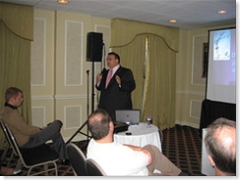 Charles Pizzo’s hands-on workshop provided participants with a checklist for internet newsrooms.
Charles Pizzo’s hands-on workshop provided participants with a checklist for internet newsrooms.
He started by pointing out that newsrooms should make life easy for reporters. So, the navigation buttons and links should appear on every page in order to make navigating the site simple and quick.
The newsroom should be designed for journalists on deadline. One thing that too many newsrooms bury is the basic facts on the company. Reporters will need to check these facts for updates with every filing. So, they should be no more than one click away.
Some basic rules:
Corporate blogs and blogs should be interlinked with the newsroom. The blog allows for dialogue which has traditionally not been readily available in newsrooms. This information will now become part of the hard (factual) and soft (feelings, impressions) information that reporters will use in their research.
Newsrooms should be optimized for search engines. This is even more important in the era of blogs. As blogs rise to the top of search engine results, they are pushing corporate newsrooms down the list of search engine results.
RSS feeds should enable reporters to subscribe to streams of information that reflects their interests.
There should be one click access to the newsroom on the corporate website home page.
The most common mistake on net newsrooms is to provide the most basic information. Who we are. What we do. Some reporters would like 25 word and 5 word versions of the company descriptor.
Contact data should be prominently displayed in the newsroom and on the releases section. Mark media contact numbers clearly as “For media inquiries only.” Also post numbers for people looking for other contacts (e.g. accounting; customer service; central switchboard.)
Ensure that dates permanently appear at the top of all news releases in the archive.
Embed links in online releases. Use bullet points to ensure that reporters can scan quickly.
Provide links to “printer friendly” versions of all pages and releases.
Companies operating in a technical or specialized area should include “glossaries” of terms and acronyms.
Don’t be afraid to correct misinformation on your newsroom. Coca Cola actually has a “Myths and Rumors” section that provides authoritative information.
Most importantly, ensure that the newsroom has a Search bar.
Mix text and art in news releases to enhance readability and provide essential information. (What’s worth 1,000 words?)
Design the newsroom page to be scroll free. The entire page should be viewable without having to scroll down for additional content.
Newsrooms should contain in-depth information beyond news releases. Links to corporate responsibility; environmental policies; code of ethics, etc.
A FAQs page should contain responses to issues and questions that are topical.
Artwork should be posted in high and low resolution (printable) versions, along with corporate videos (e.g. quarterly results) and B-roll videos.
Post positions papers, white papers, presentations and research to reporters to download and use.
Finally, include a Feedback form to enable reporters to tell you what they liked and didn’t like, what they would like you to add or change.
Charles’ complete set of slides can be downloaded from www.charlespizzo.com/pr06.
 Jeremiah Owyang spoke to the topic of Community marketing: Turn executives into powerful evangelists for the company message.
Jeremiah Owyang spoke to the topic of Community marketing: Turn executives into powerful evangelists for the company message.
Community Manager is a new role that is now appearing in many companies.
The role of PR is to be message enablers. This will involve learning the new communication tools and helping other executives and product managers to use them.
Community marketing is about giving up control and sharing it with the community. It is message enablement, not message control. It entails getting everyone in the company involved.
Community tools that Jeremiah uses:
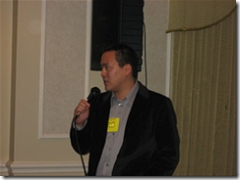 When looking for corporate bloggers, look for these factors:
When looking for corporate bloggers, look for these factors:
Community marketing opens you up to critics. (e.g. Network Storage blog) How do you respond?
Engage quickly. If someone complains about a specific problem, engage them quickly and let them know they have been heard and promise a substantial answer/action as soon as possible. Robert did this with the Network Storage blogger. Following direct outreach from Jeremiah, the Network Storage blog became more balanced in its views.
In effect, Jeremiah had applied media relations practices to blogger relations. He demonstrated that he was taking the critical blogger seriously and made a genuine effort to respond to his concerns. The results: a critic who became a balanced commentator.
 You are giving up a little bit of control to gain much more in benefits of positive community perceptions. Be part of the community, not the object of the communities frustrations.
You are giving up a little bit of control to gain much more in benefits of positive community perceptions. Be part of the community, not the object of the communities frustrations.
Once you have credible bloggers, they can play a useful role in the announcement of new initiatives and products. If they are enthused about what is being announced, that enthusiasm will come through in their posts.
In initiating these programs, Jeremiah took the initiative without involving the IT Department. The hosted nature and low cost of most social media tools makes it possible to move forward without the overhead of IT Department involvement. According to Jeremiah, “It is better to ask for foregiveness than to ask for permission, which will not be given.”
How do you measure ROI? Blog resonation: Who’s linking to your blog? Technorati wil tell you that. Resonation: You blog stats will show you how long people are staying at each visit and what are they reading. Comments: If people are commenting, you have engagement with your community.
Things that Jeremiah has tried that required adjustments-on-the-go:
 Shel Holtz took us into the world of podcasting. His presentation was titled, Mix Podcasting and PR: How the audio revolution can support clients’ objectives.
Shel Holtz took us into the world of podcasting. His presentation was titled, Mix Podcasting and PR: How the audio revolution can support clients’ objectives.
Podcasting is essentially online downloadable audio which can be received by subscription to an RSS feed.
Although podcasts can be transferred to MP3 players, 56% of people listen at their computer. Recognizing this, an increasing number of podcasts provide their signal on a streaming flash player to enable listening right off the site.
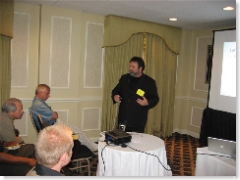 There are a diverse range of podcast directories that can be used to find content. Podcast Alley. Yahoo. Podshow. However, the cast majority of people who subscribe do so through … iTunes.
There are a diverse range of podcast directories that can be used to find content. Podcast Alley. Yahoo. Podshow. However, the cast majority of people who subscribe do so through … iTunes.
Who listens to podcasts? According to Arbitron, 11% of adults have downlaoded a podcast. 45% of the listenership is aged 35 to 44. They are educated, affluent and trend leders
Podcasts appeal to people who are hungry for niche content.
Podcasting has many advantages:
 Podcasting tools are freely available:
Podcasting tools are freely available:
Through podcasting, a small company can attach its brand to compelling, interesting content in a way that only large companies could achieve previously through broadcast advertising.
Podcasts should be incorporated into a comprehensive PR program. As part of a program, they can:
Shel also offered some secrets for successfulpodcasting
Shel practises what he preaches. For an example of a successful communications podcast, look at For Immediate Release: The Hobson and Holtz Report, which Shel co-hosts with Neville Hobson.
 Jen McClure, Executive Director of the Society for New Communications Research, titled her presentation New Tools, New Rules, New Skills & A New Role for PR.
Jen McClure, Executive Director of the Society for New Communications Research, titled her presentation New Tools, New Rules, New Skills & A New Role for PR.
Social media tools enable communicators to reach interested audience in a direct way that enables them to engage with them. Communicators can not only reach these audiences, but can listen to the audiences and become an expert resource for them.
As companies come to understand the potential of blogging, the fear of its consequences is abating.
In the “new world of pr,” we have the opportunity to deal with mainstream media analysts in a new way that will build credibility and a positive relationship. By offering genuine insight and content that flows from expertise, communicators can become a sought after and quoted source.
PR professionals must become more technologically savvy. We need to understand the technology and learn how to apply it to our clients’ purposes.
As a first step, all media releases should have an RSS feed.
Rich content (video and audio) blog posts are a cost effective alternative to traditional video news releases.
Social Media Club and Society for New Communications Research are working together on standards for a new media release format which will use RSS and tagging to present information in a way that will give the media what they want in a way they need it.
New rules:
New tools are being developed and released. Looking at the future, we must stay on top of these.
To start using social media:
Smart companies will proactively establish a blogging policy. They recognize that their employees will be blogging. Rather than ignore this, these companies provide guidance regarding what is proper and appropriate that will help their blogging employees to avoid problems before they occur.
And how about the lawyers? Won’t they object strongly to blogging as an uncontrollable medium? As we have more experience which tells us that the problems are rare, we should be able to make a case for this. Also, start with what’s already in place. Most companies have ethics policies and employment agreements with nondisclosure agreements. This should provide a good starting point. And involve the lawyers early in the process so that they can come to grips with it.
 Robert Scoble‘s topic for his keynote presentation was Naked conversations: How blogs are transforming your public relations—and your business.
Robert Scoble‘s topic for his keynote presentation was Naked conversations: How blogs are transforming your public relations—and your business.
He kicked off his remarks by retelling the story of his departure from Microsoft. The news spread from his telling a handful of bloggers, who posted their “scoop.” Mainstream media took their cue from the blog buzz, followed in far greater numbers than they would have otherwise. Robert says that this illustrates the need for public relations practitioners to pay attention to the blogosphere.
Many bloggers want to break out of the echo chamber of the blogosphere to reach the “mass market.” This has usually been done through mainstream media coverage.
The other way to reach the masses is to rank higher on search engines. Most people find websites through search. It’s a “google world.” And it’s important to be on the front page of google results because most people never click on the second page of results if they can find something they want on the first page.
 The online way to finding a larger audience? Blogs, with their frequent postings, attract links. And this moves them up on the google rankings.
The online way to finding a larger audience? Blogs, with their frequent postings, attract links. And this moves them up on the google rankings.
To attract links, it is important to offer new and original content. Many people, lawyers for example, feel that they cannot share their knowledge for free. They feel that it will reduce its value. On the blogosphere just the opposite is true. By sharing knowledge, the blogger will attract an audience who will link to him. Through this his prominence on the search engines will increase and more people will find him – including potential customers and clients.
As the blogosphere becomes more popular, bloggers will be competing with an increasingly crowded field for attention. How will they be able to continue to stand out and attract attention? Robert suggests that video will provide bloggers with the means to stand out.
Robert suggests that PR practitioners should take a cue from bloggers and begin to post video press releases in order to really stand out from the crowd. It’s harder to do video. For the time being, video will stand out because of its relative scarcity.
 Companies may also pay another price for ignoring the blogosphere. Robert pointed to the well-known story of “Dell Hell.” Blogger Jeff Jarvis was having problems with his Dell computer. He complained on his blog and he complained directly to Dell. Dell ignored him. He posted again and again. Other bloggers picked it up. And eventually the New York Times and other mainstream media picked up the story. By ignoring the blogosphere chatter that Jarvis had started, Dell ultimately was portrayed as nonresponsive, uncaring and providing inferior customer support.
Companies may also pay another price for ignoring the blogosphere. Robert pointed to the well-known story of “Dell Hell.” Blogger Jeff Jarvis was having problems with his Dell computer. He complained on his blog and he complained directly to Dell. Dell ignored him. He posted again and again. Other bloggers picked it up. And eventually the New York Times and other mainstream media picked up the story. By ignoring the blogosphere chatter that Jarvis had started, Dell ultimately was portrayed as nonresponsive, uncaring and providing inferior customer support.
Another aspect of blogging is speed of information transfer. The news cycle has been broken. A story which hits the blogosphere can spread globally through thousands of blogs within hours. This can generate buzz. It also can make the formal announcement old news by the time it happens.
Smart journalists have begun to use this. By establishing Technorati or Google keyword searches on topics of interest to them, they can pick up news as it is percolating up through the blogosphere. In doing this, they can get ahead of the story and develop scoops.
One of the mistakes that Scoble has seen companies make when confronted by this type of story is to refuse to comment. They miss the opportunity to inject their own perspective into the story. (This is not a problem unique to blog-generated stories. But the blogosphere has definitely shortened the time to respond.)
Audio and video get linked to more often than text. Learn from this and enrich the content you post.
New horizons: Second Life. Interesting things are being done there. Companies are experimenting with new branding experiences in Second Life, testing them with a small group of people there and creating buzz for themselves.
One piece of advice to PR practitione8rs who want to pitch bloggers for coverage. Read the blog first. Know the content. Make sure the blogger cares and writes about what you are pitching.
One interesting thing I noted during Robert’s presentation. Very few people indicated that they are using many of the tools that bloggers take for granted. This at a conference with a dedicated social media stream. Yet another piece of evidence that the PR industry continues to lag in understanding and adopting social media.
Robert’s presentation was pitched at the perfect level for a group of people who are relatively new to blogging and social media. It was a rambling presentation. But it covered all the topics with real life examples and in accessible language.